BELT BUCKLE CONSTRUCTION
The belt buckles
of the Third Reich were built from a variety of materials. There are instances
in which the type of material is dictated by the period of the war in which the manufacturing
took place. Some of the materials grew scarce as the war progressed and the tied turned against
Germany.
This information is provided free of charge to the visitor/enthusiast courtesy of
MilitaryItems.com,
a company dedicated to the preservation of military history and to providing quality
military antiques and collectibles to museums, institutions and the general public.
MATERIALS
The belt buckles of Nazi Germany are manufactured of a variety of materials. They included aluminum (started
in the early 1930's), steel and brass.
THE CATCH
The following is a list of the most common catches found in the belt buckles. Some of the
catches are specific to a certain type of belt buckle. For example, the "Cave" catch is
pronarily found on the SA belt buckles.
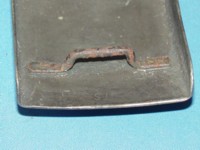 |
Square Type
Consists of posts that create 90 degree angles. The base is enforced by supports that extend to the left and
right of the base posts. The catch is spot welded to the body.
|
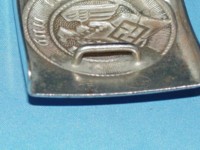 |
Rounded type
Very similar to the square type except that the corners are rounded and there are no extra support braces.
The catch is an integral component of the body.
|
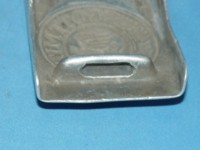 |
Thick Type
This catch system consists of thick posts and bridge. They are consideably thicker than other catches.
They are fully integrated to the body of the buckle.
|
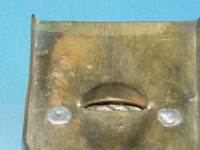 |
Cave Type
This type of catch mechanism is fully integrated with the body of the buckle. It consists of an opening
that makes a cave structure where the opposite end of the belt can be secured.
|
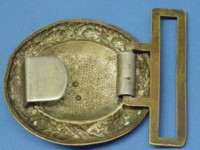 |
Heavy Type
This type of catch mechanism is fully integrated with the body of the buckle.
|
SECURING THE BELT BUCKLE
The German design of military equipment during World War Two was fairly complex. From
the development of the Tiger tank to aircraft. Their engineering tended to be very good but
more complicated than it should have. The development of the belt and belt buckle is no
exception.
The following photos illustrate how the belt buckle was worn.
Belt flap photo
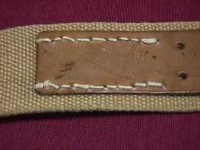 |
The belt had an extra leather flap sewn to its inside. The flap had multiple sets of
holes punched in it. This would allow the soldiers to adjust the belt buckle to accomodate
for varying waist sizes.
|
Belt Buckle Prongs photos

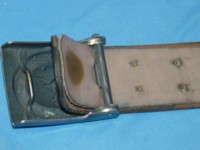 |
The buckle was equipped with two equal length prongs which were attached to a cylindrical
structure. This design allows the prongs to move well over 180 degrees. This action
facilitates the ability of the prongs to be attached to the flap of the belt.
|
Belt hook photo
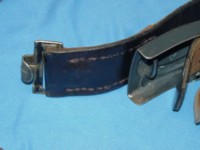 |
One end of the belt has a hook attached to it. The hook was employed to secure the end to the
catch in the belt buckle. Once in place the belt was firmly attached to the soldier.
|
This belt buckle along with the other types are currently being
reproduced. It is becoming more
difficult to be able to tell the fake ones from the real ones because the quality of the
reproductions is improving. The collector must become familiarized with the construction
style and materials employed in the manufacturing of this badge. Attention to the details
is critical in order to be able to determine the authenticity of the buckle.
If you have an interest is seeing other belt buckles of the Third Reich, you can do so by
going to our
WWII German Belt Buckles
identification guide. Where we cover Heer (Army), Navy (Kriegsmarine), Air Force
(Luftwaffe) and other organizations.
|





